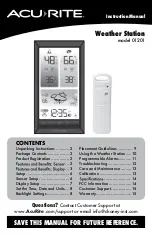
Version 3 - 12/22/2011
Page 24 of 26
Optional Wireless Outdoor Sensor: Up to 2 Years
Dimensions
Wireless Display: 5.18” L x 1.13” W x 5.56” H
Wireless USB Transceiver: 3.22" L x .36" W x .89" H
Optional Wireless Outdoor Sensor: 1.5" L x .83" W x 5.05" H
Weather Direct® LITE Update Rate
Every 6 Hours
Weather Direct® LITE Wireless Range
Up to 100 Feet (open air)
Power Requirements
NOTE:
Rechargeable batteries are not recommended due to the wide variation in
performance between brands and types. Please use only fresh Alkaline batteries.
Wireless Display: 3 “AAA”
Alkaline
Batteries (not included)
Wireless Gateway: Included AC Adapter & LAN Cable
Optional Wireless Temperature Sensor: 2 “AA”
Alkaline
Batteries (not included)
Liability Disclaimer
•
The manufacturer and supplier cannot accept any responsibility for any incorrect
readings and any consequences that occur should an inaccurate reading take place.
•
This product is designed for use in the home only as indication of the temperature
and weather forecast for the selected location.
•
This product is not to be used for medical purposes or for public information.
•
The specifications of this product may change without prior notice.
•
This product is not a toy. Keep out of the reach of children.
FCC Statements
Statement according to FCC part 15.21:
Modifications not expressly approved by this company could void the user's authority to operate
the equipment.
Statement according to FCC part 15.105:
NOTE: This equipment has been tested and found to comply with the limits for a Class B digital
device, pursuant to Part 15 of the FCC Rules. These limits are designed to provide reasonable
protection against harmful interference in a residential installation. This equipment generates
uses and can radiate radio frequency energy and, if not installed and used in accordance with the
instructions, may cause harmful interference to radio communications.
However, there is no guarantee that interference will not occur in a particular installation. If this
equipment does cause harmful interference to radio or television reception, which can be
determined by turning the equipment off and on, the user is encouraged to try to correct the
interference by one or more of the following measures:



































